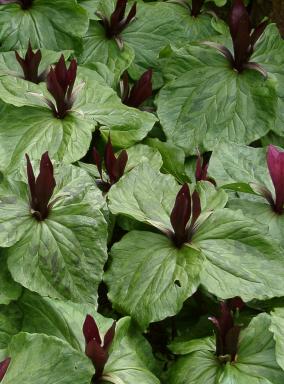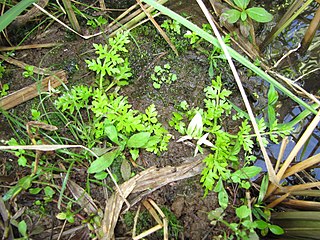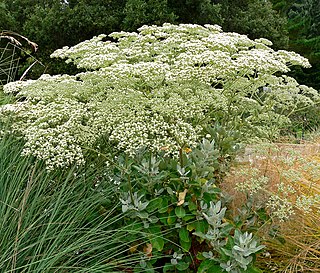
Rhododendron is a very large genus of about 1,024 species of woody plants in the heath family (Ericaceae). They can be either evergreen or deciduous. Most species are native to eastern Asia and the Himalayan region, but smaller numbers occur elsewhere in Asia, and in North America, Europe and Australia.

Trillium chloropetalum, also known as giant trillium, giant wakerobin, or common trillium, is a species of flowering plant in the family Melanthiaceae. It is endemic to the western U.S. state of California, being especially frequent in and around the San Francisco Bay Area.

Smilacaceae, the greenbriers, is a family of flowering plants. While they were often assigned to a more broadly defined family Liliaceae, most recent botanists have accepted the two as distinct families, diverging around 55 million years ago during the Early Paleogene. One characteristic that distinguishes Smilacaceae from most of the other members of the Liliaceae-like Liliales is that it has true vessels in its conducting tissue. Another is that the veins of the leaves, between major veins, are reticulate (net-shaped), rather than parallel as in most monocots.

Ranunculaceae is a family of over 2,000 known species of flowering plants in 43 genera, distributed worldwide.

Verbascum thapsus, the great mullein, greater mullein or common mullein, is a species of mullein native to Europe, northern Africa, and Asia, and introduced in the Americas and Australia.

Thalictrum is a genus of 120-200 species of herbaceous perennial flowering plants in the buttercup family, Ranunculaceae, native mostly to temperate regions. Meadow-rue is a common name for plants in this genus.

Caulophyllum thalictroides, the blue cohosh, is a species of flowering plant in the Berberidaceae (barberry) family. It is a medium-tall perennial with blue berry-like fruits and bluish-green foliage. The common name cohosh is probably from an Algonquian word meaning "rough". The Greek-derived genus name Caulophyllum signifies "stem-leaf", while the specific name thalictroides references the similarity between the large highly divided, multiple-compound leaves of meadow-rues and those of blue cohosh.
Squaw root is a common name which can refer to a number of different herbs native to North America:
Cohosh is a common name in the English language for several loosely related woodland herbs. The name may derive from Algonquian '*kkwὰhas', meaning 'rough', possibly describing leaves or compound flowers.

Ceratopteris thalictroides is a fern species belonging to the genus Ceratopteris, one of only two genera of the subfamily Parkerioideae of the family Pteridaceae.

Caulophyllum is a small genus of perennial herbs belonging to the family Berberidaceae and closely related to the Eurasian genera Leontice and Gymnospermium. It is native to eastern Asia and eastern North America. These plants are distinctive spring wildflowers, which grow in moist, rich woodland, it is known for its large triple-compound leaf, and large blue, berry-like fruits. Unlike many spring wildflowers, it is not an ephemeral plant and persists throughout much of the summer. Common names for plants in this genus include blue cohosh, squaw root, and papoose root. As hinted at by its common names, this plant is well known as an alternative medicine for inducing childbirth and menstrual flow; it is also considered a poisonous plant.

Allium giganteum, common name giant onion or giant leek, is an Asian species of onion, native to central and southwestern Asia but cultivated in many countries as a flowering garden plant. It is the tallest species of Allium in common cultivation, growing to 1.5 metres (4.9 ft).

Eriogonum giganteum, with the common name St. Catherine's lace, is a species of wild buckwheat in Southern California.

Cardiocrinum giganteum, the giant Himalayan lily, is the largest species of any of the lily plants, growing up to 3.5 metres high. It is found in the Himalayas, China and Myanmar (Burma).

Enemion biternatum, commonly known as the false rue-anemone, is a spring ephemeral native to moist deciduous woodland in the eastern United States and extreme southern Ontario.

Chenopodium giganteum, also known as tree spinach, is an annual, upright many-branched shrub with a stem diameter of up to 5 cm at the base, that can grow to a height of up to 3 m.

Synandra is a monotypic genus of flowering plants in the mint family containing the single species Synandra hispidula, which is known by the common name Guyandotte beauty. It is native to the east-central United States where it ranges from southern Illinois to western North Carolina and Virginia.

Sequoiadendron is a genus of evergreen trees, with two species, only one of which survives to the present:

Lolium giganteum, giant fescue, is a woodland grass that grows on neutral to base-rich soils, often near streams or other damp places. It is native to Europe and much of Asia and has been introduced to parts of North America.
















